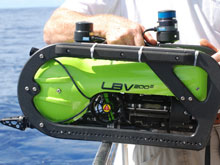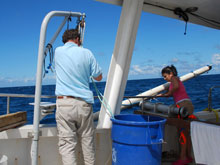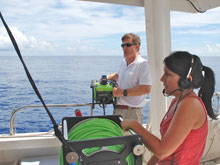
The SeaBotix LBV (little benthic vehicle) is a remotely operated vehicle (ROV) that researchers will use to explore potential underwater caves. Its small size (just 21 inches in length) makes it an ideal tool for exploring small underwater spaces. Click image for larger view and image credit.
Working with Small ROVs
September 25, 2009
Krystle Gomez
California State University – Monterey Bay
The remotely operated vehicle (ROV) we’re working with is a SeaBotix LBV (little benthic vehicle). Typically, we use it for work in coastal waters, such as Monterey Bay. This will be the first time we have used the LBV to explore underwater caves. The LBV is small — measuring 21 inches long, 9.65 inches wide, and only weighing about 27 pounds — and it is equipped with a rotatable high-definition video camera, lasers for measurement of underwater features, and four light emitting diode (LED)-powered lights.
The LBV can go down to 200 meter (656 foot) depth, which perfect for looking into caves. Additionally, its small size makes it ideal for exploring tight spaces. Its size also makes it fairly simple to deploy and recover. While we can operate it with as few as three people, we have a team of five, including the boat captain. We work together to deploy, pilot, and recover the LBV.

Dr. Rikk Kvitek and graduate student Krystle Gomez position the acoustic transducer off the side of the boat. This transducer works with a global positioning system (GPS) to track the location of the ROV on its dives. Click image for larger view and image credit.
First, Position the Boat
The first step in our procedure is to position the boat close to our area of interest. We need to keep the boat relatively stable, so there are three options for maintaining position: hard anchor, sea anchor, or live boat. For a hard anchor, we simply drop the anchor down to the bottom; but in deeper areas, or areas where there are corals or other sensitive bottom habitats, this option isn’t available. The sea anchor is a large weighted “underwater parachute” that provides drag in the water and helps to keep the boat from drifting too far from a location. Finally, live boat is when we don’t anchor and use small boat movements and the currents to keep position.
Both the sea anchor and live boat options allow us flexibility to explore larger areas as we are not limited to the length of the anchor chain. Live boat can be stressful, however, as you must constantly be observant of the LBV and tether. At the same time, this option also allows us flexibility to explore larger areas without having to recover and re-deploy the anchor time and time again.

A wireless headset allows Krystle Gomez to work on the back deck, communicate with the ROV pilot, and ensure a smooth deployment of the ROV. Click image for larger view and image credit.
LBV Deployment
Prior to deployment, we position an acoustic transducer (a device that converts electrical to acoustic energy) in the water off the side of the boat. This transducer has a GPS (global positioning system) attached to it that relays the exact position of the LBV while on its dives. The LBV has an acoustic sounder, which communicates with the transducer off the side of the boat. When the transducer receives a signal from the LBV, its position is recorded with the GPS unit.
Deployment takes about five minutes in ideal conditions. During this time, communication is essential to a smooth operation. There needs to be constant communication between the crew deploying the LBV, the pilot, and the boat captain. As the captain positions the boat, the deck crew puts the LBV overboard and begins to feed out the tether — no cranes needed here! For deeper explorations, we also deploy a weight to keep the tether from floating to the surface.
Once the LBV is in the water and ample tether has been fed out, the pilot can turn on the vehicle’s thrusters and begin the dive. Once the dive is over, we do the same process in reverse, with the pilot driving the LBV up to the surface and those of us on the deck hauling in the tether, always keeping good constant communication!
Sign up for the Ocean Explorer E-mail Update List.













